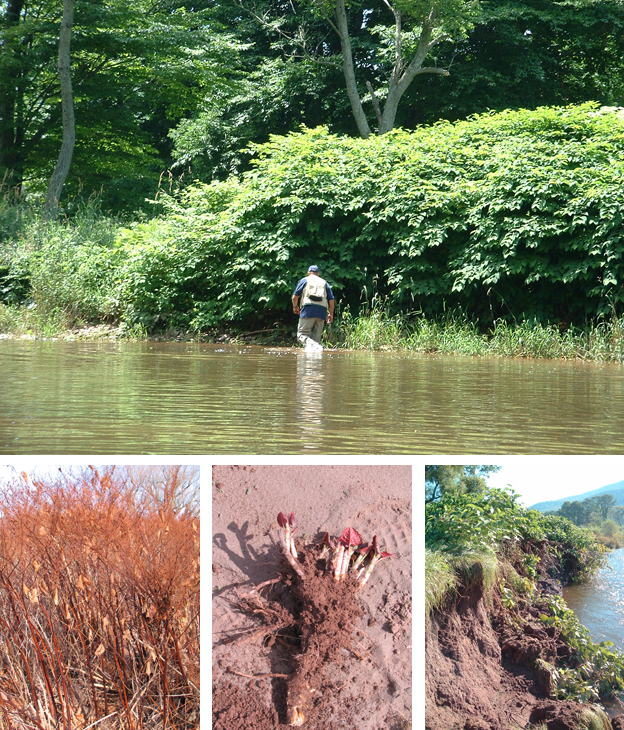Find out about the expansive negative effects of exotic, invasive
species and threats to the Catskills. This section includes information
about invasive plant control for already established species as
well as identification information for invasive species on the
fringe of the Catskill Mountains. Additionally, you can learn
about joining a new group called the Catskill Regional Invasive
Species Partnership (CRISP) that works cooperatively to address
invasive species concerns.
Click
here to read why invasive species are a problem
How to be helpful in the overwhelming world of invasive species
control:
1. First it’s important to know what plants and
animals have lived together over hundreds of years in the Catskill
Mountains. These native species depend on each other
in order to thrive. Understanding our natural surroundings makes
it easier to identify what things do not belong. To begin getting
familiar with Catskill native plants, please view our species
lists.
2. In the Catskills we have several plant species like Oriental
bittersweet or Japanese barberry that may seem native, because
they cover such a large area, but they are actually non-native,
invasive plants. While it is important to know these established
invasive plants, it is actually more critical to
learn about early detection species or non-native
plants that may only be found in limited quantities in the Catskills.
The reason being that it is much easier to control a small population
versus an extensive, established population. This pdf
includes a few slides of early detection plants that have demonstrated
negative impacts elsewhere in New York, but have not yet taken
a hold in the Catskills. The Nature Conservancy has also compiled
a list of invasive species in or near the Catskill region and developed a useful guide to preventing the spread of invasive insects and disseases.
3. Once you’ve become familiar with early
detection species and if you find one of these plants on your
own property, please make
a voucher specimen. For instructions on how to make a voucher
specimen, please refer to this document link.

4. You could also just talk to neighbors if
you notice that they are planting non-native, invasive plants
or if they are moving soil that previously had an invasive plant
growing in it. Japanese
knotweed (seen above), which has colonized miles of streambank
throughout the Catskills, was originally brought to the United
States for its aesthetic qualities. Now it often creates new colonies
when soil with small plant fragments is moved as part of bridge
maintenance or gardening projects.
5. Create a neighborhood team to help each other
control invasive species in your area. In the hamlet of Oliverea,
the Foxfire 4-H club, wrote to neighbors living along the McKenley
Hollow creek which flows in the Esopus Creek. After receiving
permission from all of the landowners, the children mapped Japanese
knotweed locations and worked together to stomp it out and cover
it. This group of enthusiastic 6-12 year olds may successfully
eliminate Japanese knotweed from their neighborhood.
6. Lastly, you could join a newly formed partnership,
the Catskill
Regional Invasive Species Partnership (CRISP). This group
consists of many agencies and organizations working in throughout
the Catskills, but is also welcome to concerned citizens. The
link within this text will lead you to a sign-on letter and more
information about CRISP.
Links and Resources
Click on the links below for more information:
Other species lists
New York State NEEDS YOUR HELP with
Invasive Species Early Detection
Click here for Trout
Unlimited’s Most Un-Wanted List
Click here for Chicago
Botanic garden list
References
Connecticut
Invasive Plant Working Group maintains a website on invasive
plants and their control, as well as announcements of conferences
and other events.
Guide
to Invasive Non-native Aquatic Plants in Massachusetts C.
Barre Hellquist and Massachusetts Dept. of Environmental Management,
Lakes and Ponds Program, Boston. 14 page booklet with line drawings,
color photos and brief descriptions. For a free copy, contact
Michelle Robinson, (617) 626-1382.
“Wisconsin
Manual of Control Recommendations for Ecologically Invasive Plants,"
edited by Hoffman and Kearns, and published by the Wisconsin Department
of Natural Resources. Copies are available by sending $3 to the
Endangered Resources Fund, Wisconsin Department of Natural Resources,
P.O. Box 7921, Madison, Wisconsin 53707-7921.
U.S. Army Corps of Engineers has produced a "Noxious and
Nuisance Plant Management Information System-PMIS" (Version
4) on CD-ROM, that discusses 60 plants, and includes pictures,
range maps, control information, and information on pesticide
regulations in 26 states. The Aquatic Plant Information System-APIS@
includes the identification and management of over 60 species
of native and introduced aquatic and wetland plants. Single copies
of each of these CD’s are available free from Michael J.
Grodowitz, U.S. Army Corps of Engineers, CEWES-ER-A, 3909 Halls
Ferry Road, Vicksburg, MS 39180 (grodowm@mail.wes.army.mil).
Not all of the plants included are problems in New England.
|

